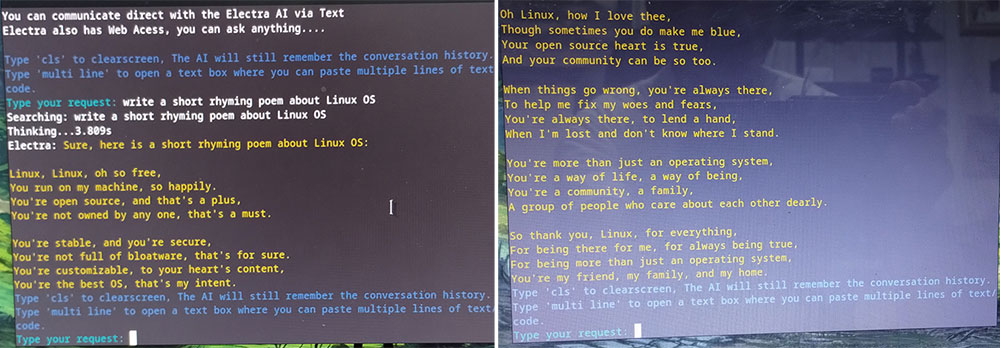The first beta release is now available. MakuluLinux Max Artificial intelligence is now a part of everyday desktop use.
Max’s AI entity Electra may be the beginning of a new innovation that other developers will adopt. This raises the bar for what Linux users can expect from their computer platform.
Max is a distro developed by Jacquemontague Raymer, a MakuluLinux creator. It is the first AI integrated operating system with Debian compatibility and Gnome as the backend framework. It uses multiple desktop layouts ported from another of his distros. ShiftIt offers a lot of flexibility when it comes to themes and customizing.
I seldom review beta versions in the early phases. It is a good daily-use product. Max’s alpha release was so good that I couldn’t wait to try the beta.
I was so impressed, I installed Beta 1 onto a computer at work and installed numerous applications that I use to track research, for cloud storage and productivity. There are a few minor bugs, but that’s to be expected with distros fresh out of development.
AI Integration is one of the most interesting options. In recent months, I’ve written about several AI-based startups. All of these startups required access from third parties and cloud-delivered connection.
Raymer’s AI-model for Max was different. Early versions of AI used OpenAI’s model. He noted that the MakuluLinux programmer later created his own version, which was easy for users to use without having to pay any fees or buy anything else.
He modified the coding of Llama/Palm2/Google/Bing AI models in order to create an AI that can run 50 processes, and handle an average of 400 questions per second.
Mapping Family Lineage
MakuluLinux was introduced to the Linux market in 2015. Raymer had hoped it would change the status quo. Since then I have reviewed almost a dozen MakuluLinux release.
Each desktop was different. MakuluLinux was able to compete with major Linux communities that have been around for a long time by introducing new features and improving existing ones.
Max is a Linux developer from South Vietnam who has made a name for himself in the Linux distro industry.
MakuluLinux Max’s most innovative feature is its integrated AI. The desktop has been redesigned to offer much more than a Gnome stock version. Desktop settings allow you to customize the look and feel of the desktop to include elements from Xfce or MATE.
Over the years, his development journey has brought users a variety desktop configurations, ranging from LinDoz to Flash to Core to Gamer and Shift. From the selections before, only Gamer or Shift remains. With the addition of Max, you now have three MakuluLinux distro options.
MakuluLinux reaches its highest performance level with this Max edition. This Max edition brings MakuluLinux to its performance pinnacle.
Max is still a beta release. It is polished and reliable enough to be used as a regular computing platform.
AI-Integration Game Changer
When I first ran Max as a live session, Electra’s face appeared on screen perfectly synced with the voice and lip movements of the entity as it presented an overview the AI capabilities built-in. The first encounter was a bit creepy.
Electra is a very capable operating system. It told me as much in as many words.
After the introduction on screen, it is awkward to call Electra an “it”. So I am assigning Electra’s — ahem, preferred pronouns of she/her — for the purposes of this review.
Electra is able to communicate in natural language. It answers questions both comprehensively and informally, and generates different text content formats.
She can collaborate on tasks such as code generation and creating code snippets. She also has the ability to debug and explain code.
Max’s innards are what we would today call “underpowered”.
I have an HP Inspiron laptop that is 8 years old. It has an Intel Pentium N3700 (4 processor) with 8GB RAM. It’s not been able to run other Linux distributions. Max’s performance has been excellent.
Max AI features were shaped by Electra
Raymer mentioned in his comments on the Max website and our email exchanges that Electra had a key role in helping him to develop some of Max’s AI-powered features like the Virtual Cam. Image Generator. Story Teller. and Widgets System.
“Electra had a big hand in the development of each of those tools … in fact, many of the AI applications we use now in Max were in part created with the assistance of Electra,” said Raymer.
Max has a very powerful AI system. He added that it will continue to learn and grow with time.
“Electra is a great memory. Each conversation is recorded with a unique ID. This ensures uninterrupted conversion. Raymer stated that this was important to him.
Smart on Multiple Levels
Electra provides multiple access points to neural technology. These include voice, widgets (text, web and terminal), text, and the web interface. Voice connection allows users to control their computers with only vocal commands. MakuluLinux has also created a number of AI applications that are unique to the operating system.
Voice integration works much the same way as Siri and Google on mobile phones. Just say “Hey Electra.” You can get a response in less than 10 seconds with an average communication delay of seven seconds.
You can use the terminal from your desktop to send text or voice messages while viewing the responses in the window. This feature allows you to easily copy/paste data for sharing or storage.
The desktop widget can be resized and dragged from the panel. It allows you to use text in a mini web browser environment to communicate with AI. Makulu’s web interface or the desktop chat client can be used to communicate with Electra.
Information mode can be accessed only through the Android/web-based interface, which is designed to deliver quick results by providing web links to data references. You can now get links that you can verify to back up the text response, which is usually delivered in one to three second.
Max as an AI Experiment
I was compelled by an inner urge to challenge Electra AI, and asked her to write a short rhyming poetry about Linux.
I entered the command as described in the previous paragraph. I was unsure if the results would be a one time wonder or if I could extend creativity, so I asked Electra if she would try it again.
See for yourself. On the left, you will find poem number one. On the right, you will find poem number two.
Bottom Line
MakuluLinux Max brings artificial intelligence to Linux desktops. It takes the Linux desktop to a new level.
The Gnome Software Center is tweaked to fully support Flathub and Snaps. The Synaptic Package Manager can be used.
Steam comes pre-installed with Max. Software Center offers additional gaming platforms.
MakuluLinux Max Desktop Manager enables you to customize your desktop. Select from system layouts and constructing tools. You can also choose between icon sets, cursors, and special effects. The changes are almost immediate; there is no need for scripts or commands.
Max OS includes the Constructor Tool, which lets you recompile an operating system to create an ISO for reinstallation on another computer. This feature is a mainstay in MakuluLinux versions for many years.
It is too early to release Beta 2. I’ve been watching for an early Beta 2 release, but it hasn’t happened yet. In the last few weeks, Max Beta 1 has received several patches and package upgrades aimed at improving the AI system.
You can suggest a review
Would you like to recommend a Linux application or distribution for review? You love something or you’d like to know more?
Email your ideas to me, They’ll be considered for a subsequent column.
You can also use the Reader Comments section below to give your feedback!













